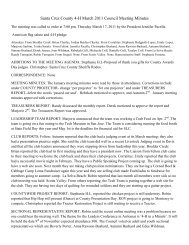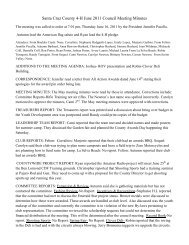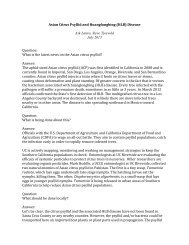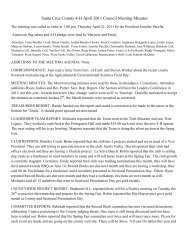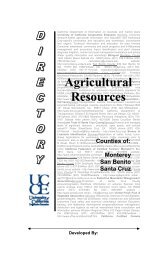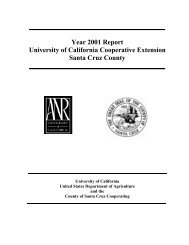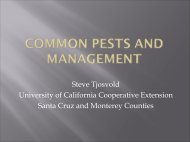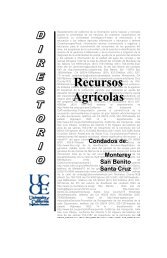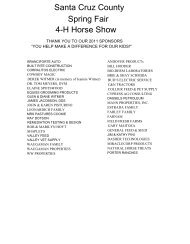Zalom Watsonville Strawberry Talk 2012 - Santa Cruz County
Zalom Watsonville Strawberry Talk 2012 - Santa Cruz County
Zalom Watsonville Strawberry Talk 2012 - Santa Cruz County
- No tags were found...
You also want an ePaper? Increase the reach of your titles
YUMPU automatically turns print PDFs into web optimized ePapers that Google loves.
Annual Central Coast <strong>Strawberry</strong> Meeting<strong>Watsonville</strong>, February 2, <strong>2012</strong>Recent Studies of Controlsfor LygusFrank <strong>Zalom</strong>Department of EntomologyUniversity of California, Davis
Lygus
Lygus MonitoringDetermine when to make a control action….• Monitor alternate hosts (including infested olderstrawberry plantings to determine when adults arepresent that may move into the newer strawberries• Treat or destroy the alternate hosts before nymphsbecome adults, if practical, to avoid movement ofadults to the newer strawberries• Monitor the winter-planted strawberries to determinewhen the first adults appear to establish the biofix• Treat with appropriate products depending on the agestructure of a population (e.g. Rimon is a growthregulator, so will only be effective on nymphs), savethe products that will also kill adults for later
Registered insecticidesPesticide Chemical Subgroup Target Site of Activity IRAC #Malathion malathion organophosphate acetylcholine esterase inhibitor 1BDibrom naled organophosphate acetylcholine esterase inhibitor 1BDiazinon diazinon organophosphate acetylcholine esterase inhibitor 1BBrigade,Bifenture, bifenthrin pyrethroid sodium channel modulator 3AthenaDanitol fempropathrin pyrethroid sodium channel modulator 3• Nerve poisons• Kill nymphs and adults• Problems with resistance• May be valuable as synergists in tank mixes
Malathion, Dibrom, DiazinonOrganophosphates - Synaptic poisonsAch• acetylcholine transmits impulse across synapse• acetylcholine is broken down by acetylcholinesteraseto stop the signal• organophosphate and carbamate insecticides inhibitacetylcholinesterase
Malathion, Dibrom, DiazinonOrganophosphates - Synaptic poisonsAch• organophosphate and carbamate insecticides inhibitacetylcholinesterase• causes a build-up of acetylcholine and nerves continueto fire• insect death preceded by tremors, convulsions, andparalysis
Danitol, Brigade, Bifenture, AthenaPyrethroids - Axonic poisons• pyrethroids act on tiny channels through which sodiumis pumped to cause excitation of neurons• bind to a protein in nerves called the voltage-gatedsodium channel
Danitol, Brigade, Bifenture, AthenaPyrethroids - Axonic poisonsX• pyrethroids act on tiny channels through which sodiumis pumped to cause excitation of neurons• bind to a protein in nerves called the voltage-gatedsodium channel• they prevent the sodium channels from closing,resulting in continual nerve impulse transmission,tremors, and eventually, death.
Registered insecticidesPesticide Chemical Subgroup Target Site of Activity IRAC #Actara thiamethoxam neonicotinoid nicotinic Ach receptor agonists/ 4AantagonistAssail acetamiprid neonicotinoid nicotinic Ach receptor agonists/ 4AantagonistRimon novaluron benzoylureas inhibitor of chitin biosynthesis, 15type 0Prevam sodiumtetraborohydratedecahydrate__ nonspecific inhibitor uncl• Nerve poisons• Insect growth regulator• Contact poison with little residual activity
Actara, AssailNeonicotinoids - Synaptic poisonsAch• mimic acetylcholine and nerves continue to fire• closer mimics to the insect acetylcholine thanmammalian acetylcholine so fairly non-toxic to mammals• insect death preceded by tremors, convulsions, andparalysis
RimonInsect growth regulator - Chitin synthesis inhibitorChitin - polymerized compoundthat forms the exocuticleHow does this work?Gives the cuticle its strength and resilience
RimonInsect growth regulator - Chitin synthesis inhibitorincomplete metamorphosis,nymphs must ‘molt’ in order to grow
RimonInsect growth regulator - Chitin synthesis inhibitor• blocks the production of chitin• insect poisoned cannot make chitin and so cannot molt• insect remains in same life stage and eventually dies
Lygus Control, <strong>Watsonville</strong>, 2010Timed to nymphal hatch of first generationFirst year ‘Albion’Rimon treatment dates:June 11, 2010June 18, 2010 (Rimon treatments only)Treatments:UntreatedRimon @ 12 oz (2 applications)Rimon @ 12 oz + Dibrom @ 16 oz (2 applications)Bifenture 10DF @ 16 oz (1 application)Assail 30SG @ 6.4 oz + Bifenture @ 16 oz (1 application)Plot size - 6 rows wide x 67’ longFruit > 0.75” were removed prior to treatmentSampled 80 plants per plot for Lygus and fruit damage
Lygus Control - 2010ResultsRimon affects molting
Lygus Control - 2010Mean number of fruit damaged at 27 and 35 daysafter first treatment, <strong>Watsonville</strong>, 2010Mean + SE fruitdamaged/plantTreatment Rate (form/ac) 7/8/10 7/15/10Untreated NA 1.07 ± 0.18 2.43 ± 1.18Assail + Bifenture * 6.4 oz + 16 oz 0.91 ± 0.52 1.01 ± 0.15Bifenture * 16 oz 1.73 ± 0.28 1.52 ± 0.63Rimon 12 oz 0.54 ± 0.36 0.77 ± 0.28Rimon + Dibrom 12 + 1 pt 1.06 ± 0.59 0.52 ± 0.26Application dates - all treatments 6/11/10 and 2nd Rimon treatment 6/18/10* plus DyneAmic at 0.25% v/v
Rimon spring spray, <strong>Watsonville</strong>, 2010Timed to first nymphsSecond year ‘Albion’ withhigh infestation levelsRimon treatment dates:March 23, 2010April 5, 2010Treatments:Untreated controlRimon 0.83EC @ 12 oz per acre (2 applications)Diazinon AG500 @ 16 oz per acre (1 application)Plot size - 12 rows wide x 175’ longSampled 80 plants per plot
Rimon spring spray, <strong>Watsonville</strong>, 2010pretreatmentProblem with second yearfields - they already have aresident Lygus populationfrom the previous year, andbecause they have beensprayed the Lygus are moreresistant to olderinsecticides likeorganophosphates(diazinon, malathion,Dibrom) and pyrethroids(Brigade and Danitol)Monitoring for small nymphs to time treatments is veryimportant
Rimon spring spray, <strong>Watsonville</strong>, 2010• Rimon is best usedearly season as it onlyaffects Lygus nymphsand there is moresynchronization of theLygus generations atthat time• Later application isbest when tank mixedwith another product• Timing is critical
Yet to be registered insecticidesPesticide Chemical Subgroup Target Site of Activity IRAC #Belay clothianidin neonicotinoid nicotinic Ach receptor agonist/ 4AantagonistBeleaf flonicamid flonicamid nonspecific feeding blocker 9C-- tolyfenpyrad METI insecticide Mitochondral complex I electron 21Atransport inhibitor-- sulfoxaflor sulfilimine -- uncl• Nerve poison• Feeding blocker• Affects insect’s energy metabolism• ??
Belay and Beleaf - 2010Treatment Chemical name Rate (form/ac)UntreatedRimon 0.83EC novaluron 12 ozBeleaf flonicamid 2.8 ozBeleaf + Brigade flonicamid + bifenthrin 2.8 oz + 16 ozBeleaf + Rimon flonicamid + novaluron 2.8 oz + 12 ozDanitol fenpropathrin 10.66 ozBelay (L) clothianidin 4.0 ozBelay (H) clothianidin 6.0 ozBelay (L) + Danitol clothianidin + fenpropathrin 4.0Brigade bifenthrin 16 ozAthena bifenthrin + abamectin 17.0 ozActara 25WG thimethoxam 4.0 ozTreatments include Dyne-amic
Belay and Beleaf - Small Nymphs, 2010Mean ± SE small nymphs per plantTreatment 9/2/10 9/9/10 9/16/10 9/23/10Untreated 0.75 ± 0.11 1.16 ± 0.25 1.04 ± 0.15 0.44 ± 0.11Rimon 0.83EC 0.54 ± 0.08 0.72 ± 0.11 0.82 ± 0.10 0.56 ± 0.07Beleaf 0.29 ± 0.08* 0.69 ± 0.05 0.68 ± 0.16 0.68 ± 0.15Beleaf + Brigade 0.27 ± 0.04* 0.63 ± 0.23* 1.18 ± 0.11 0.62 ± 0.23Beleaf + Rimon 0.18 ± 0.05* 0.51 ± 0.24* 0.78 ± 0.44 0.59 ± 0.10Danitol 0.60 ± 0.18 1.38 ± 0.16 1.17 ± 0.12 0.58 ± 0.04Belay (L) 0.39 ± 0.13* 0.91 ± 0.22 1.04 ± 0.35 0.82 ± 0.22Belay (H) 0.35 ± 0.04* 0.53 ± 0.09* 0.79 ± 0.29 0.64 ± 0.08Belay (L) + Danitol 0.40 ± 0.04* 0.87 ± 0.05 0.92 ± 0.07 0.89 ± 0.16Brigade 0.71 ± 0.09 1.31 ± 0.06 1.11 ± 0.18 0.73 ± 0.06Athena 0.42 ± 0.19* 0.83 ± 0.24 0.57 ± 0.06 0.50 ± 0.06Actara 25WG 0.48 ± 0.06 0.95 ± 0.17 0.78 ± 0.05 0.55 ± 0.05* Means are significantly different from control at P
Belay and Beleaf - Total Lygus (Nymphs + Adults)Mean ± SE total Lygus (nymphs + adults) per plantTreatment 9/2/10 9/9/10 9/16/10 9/23/10Untreated 0.64 ± 0.24 1.03 ± 0.15 1.37 ± 0.25 1.26 ± 0.19Rimon 0.83EC 0.53 ± 0.18 0.73 ± 0.02 0.93 ± 0.15 1.09 ± 0.13Beleaf 0.50 ± 0.08 0.49 ± 0.11* 0.89 ± 0.01 0.86 ± 0.12Beleaf + Brigade 0.63 ± 0.31 0.47 ± 0.06* 0.83 ± 0.29* 1.46 ± 0.08Beleaf + Rimon 0.52 ± 0.17 0.35 ± 0.05* 0.67 ± 0.21* 1.01 ± 0.54Danitol 0.42 ± 0.07 0.80 ± 0.25 1.59 ± 0.21 1.45 ± 0.15Belay (L) 0.50 ± 0.20 0.57 ± 0.18* 1.14 ± 0.23 1.34 ± 0.42Belay (H) 0.68 ± 0.18 0.45 ± 0.07* 0.65 ± 0.08* 1.00 ± 0.29Belay (L) + Danitol 0.84 ± 0.09 0.57 ± 0.02* 1.11 ± 0.03 1.21 ± 0.11Brigade 0.89 ± 0.08 1.07 ± 0.08 1.53 ± 0.07 1.53 ± 0.20Athena 0.57 ± 0.13 0.55 ± 0.12* 1.22 ± 0.10 1.86 ± 0.42Actara 25WG 0.51 ± 0.07 0.74 ± 0.05 1.20 ± 0.19 1.08 ± 0.07* Means are significantly different from control at P
Belay and Beleaf - Damage at 27 and 35 daysPercent damagePercent fruit damaged per plot reductionTreatment 9/16/10 9/23/10 9/16/10 9/23/10Untreated 73.93 ± 4.00 80.87 ± 3.99Rimon 0.83EC 58.42 ± 4.30* 44.87 ± 4.11* 20.98 44.51Beleaf 53.37 ± 5.00* 52.14 ± 4.30* 27.82 35.53Beleaf + Brigade 47.19 ± 4.77* 39.78 ± 3.48* 36.18 50.81Beleaf + Rimon 49.16 ± 4.43* 51.82 ± 4.25* 33.51 35.92Danitol 49.20 ± 4.88* 65.56 ± 4.61* 33.45 18.93Belay (L) 48.31 ± 4.74* 63.02 ± 3.88* 34.67 22.07Belay (H) 52.91 ± 4.89* 38.00 ± 4.07* 28.45 53.01Belay (L) + Danitol 55.88 ± 4.85* 58.91 ± 4.37* 24.43 27.16Brigade 61.70 ± 4.66* 50.98 ± 3.67* 16.56 36.96Athena 64.00 ± 4.52 60.46 ± 5.63* 13.45 25.23Actara 25WG 69.35 ± 4.06 70.14 ± 4.85* 6.21 13.27* Means are significantly different from control at P
Lygus Control - Insecticides - 2011
tolyfenpyrad and sulfoxaflor - 2011Treatment Chemical name Rate (form/ac)UntreatedBrigade WSB bifenthrin 16 ozActara 25 WG +Brigadethiamethoxam +bifenthrin4 oz +16 ozRimon 0.83 EC novaluron 12 ozRimon + Brigade novaluron + bifenthrin 12 oz + 16 ozBeleaf 50SG flonicamid 2.8 ozBelay 2.13 EC clothianidin 4.0 ozBelay 2.13 EC clothianidin 6.0 oztolfenpyrad 15 SC tolfenpyrad 27 oztolfenpyrad 15 EC tolfenpyrad 27 ozsulfoxaflor (L) sulfoxaflor 2.85 ozsulfoxaflor (M) sulfoxaflor 4.28 ozsulfoxaflor (H) sulfoxaflor 5.7 ozTreatments applied September 30, 2011, to first year 'Albion' fieldAll include Dyne-amic
tolyfenpyrad and sulfoxaflor - Small NymphsMean ± SE small Lygus bug nymphs per plantTreatment 10/6/11 10/13/11 10/20/11 10/27/11Untreated 0.08 ± 0.01 0.16 ± 0.06 0.06 ± 0.04 0.04 ± 0.01Brigade 0.02 ± 0.02* 0.06 ± 0.02 0.02 ± 0.02 0.08 ± 0.04Mean ± SE small Lygus bug nymphs per plantTreatment 10/6/11 1 10/13/11 2 10/20/11 3 10/27/11 4Untreated 0.08 ± 0.01 0.16 ± 0.06 0.06 ± 0.04 0.04 ± 0.01Brigade 0.02 ± 0.02* 0.06 ± 0.02 0.02 ± 0.02 0.08 ± 0.04Actara + Brigade 0.03 ± 0.02 0.10 ± 0.06 0.08 ± 0.04 0.05 ± 0.04Agri-flex 0.00 ± 0.00* 0.01 ± 0.01* 0.06 ± 0.03 0.04 ± 0.02Rimon 0.01 ± 0.01* 0.06 ± 0.02 0.05 ± 0.02 0.11 ± 0.04Rimon + Brigade 0.03 ± 0.01* 0.04 ± 0.03 0.05 ± 0.01 0.06 ± 0.02Beleaf 0.03 ± 0.01* 0.03 ± 0.00* 0.04 ± 0.02 0.09 ± 0.05Belay (L) 0.03 ± 0.01* 0.03 ± 0.01* 0.02 ± 0.02 0.02 ± 0.02Belay (H) 0.02 ± 0.01* 0.01 ± 0.01* 0.03 ± 0.01 0.09 ± 0.02tolfenpyrad 15 SC 0.02 ± 0.01* 0.03 ± 0.03* 0.01 ± 0.01 0.08 ± 0.04tolfenpyrad 15 EC 0.01 ± 0.01* 0.06 ± 0.03 0.05 ± 0.01 0.12 ± 0.03sulfoxaflor (L) 0.00 ± 0.00* 0.04 ± 0.01 0.05 ± 0.04 0.06 ± 0.04sulfoxaflor (M) 0.02 ± 0.01* 0.04 ± 0.01 0.01 ± 0.01 0.05 ± 0.01sulfoxaflor (H) 0.05 ± 0.01 0.08 ± 0.02 0.04 ± 0.01 0.04 ± 0.02Actara + Brigade 0.03 ± 0.02 0.10 ± 0.06 0.08 ± 0.04 0.05 ± 0.04Rimon 0.01 ± 0.01* 0.06 ± 0.02 0.05 ± 0.02 0.11 ± 0.04Rimon + Brigade 0.03 ± 0.01* 0.04 ± 0.03 0.05 ± 0.01 0.06 ± 0.02Beleaf 0.03 ± 0.01* 0.03 ± 0.00* 0.04 ± 0.02 0.09 ± 0.05Belay (L) 0.03 ± 0.01* 0.03 ± 0.01* 0.02 ± 0.02 0.02 ± 0.02Belay (H) 0.02 ± 0.01* 0.01 ± 0.01* 0.03 ± 0.01 0.09 ± 0.02tolfenpyrad SC 0.02 ± 0.01* 0.03 ± 0.03* 0.01 ± 0.01 0.08 ± 0.04tolfenpyrad EC 0.01 ± 0.01* 0.06 ± 0.03 0.05 ± 0.01 0.12 ± 0.03sulfoxaflor (L) 0.00 ± 0.00* 0.04 ± 0.01 0.05 ± 0.04 0.06 ± 0.04sulfoxaflor (M) 0.02 ± 0.01* 0.04 ± 0.01 0.01 ± 0.01 0.05 ± 0.01sulfoxaflor (H) 0.05 ± 0.01 0.08 ± 0.02 0.04 ± 0.01 0.04 ± 0.02* Means are significantly different from control at P
tolyfenpyrad and sulfoxaflor - Total LygusMean ± SE Total Lygus bugs (adults + nymphs) per plantTreatment 10/6/11 10/13/11 10/20/11 10/27/11Untreated 0.11 ± 0.01 0.21 ± 0.06 0.17 ± 0.05 0.23 ± 0.05Brigade 0.08 ± 0.02 0.13 ± 0.04 0.11 ± 0.03 0.23 ± 0.03Actara + Brigade 0.05 ± 0.03 0.15 ± 0.06 0.11 ± 0.04 0.14 ± 0.03Rimon 0.06 ± 0.02 0.09 ± 0.02 0.08 ± 0.02 0.19 ± 0.02Rimon + Brigade 0.04 ± 0.02 0.06 ± 0.05 0.10 ± 0.04 0.10 ± 0.03Beleaf 0.08 ± 0.02 0.06 ± 0.01 0.09 ± 0.02 0.17 ± 0.07Belay (L) 0.04 ± 0.03 0.06 ± 0.01 0.03 ± 0.01 0.07 ± 0.02Belay (H) 0.02 ± 0.01 0.01 ± 0.01 0.12 ± 0.04 0.12 ± 0.03tolfenpyrad SC 0.09 ± 0.03 0.07 ± 0.07 0.06 ± 0.05 0.11 ± 0.07tolfenpyrad EC 0.03 ± 0.01 0.10 ± 0.04 0.09 ± 0.02 0.19 ± 0.04sulfoxaflor (L) 0.06 ± 0.03 0.10 ± 0.02 0.09 ± 0.06 0.15 ± 0.06sulfoxaflor (M) 0.02 ± 0.01 0.11 ± 0.04 0.07 ± 0.03 0.16 ± 0.03sulfoxaflor (H) 0.08 ± 0.01 0.12 ± 0.02 0.10 ± 0.03 0.09 ± 0.03Pre-treat count = 0.061 small Lygus nymphs per plant, 0.022 large Lygusnymphs per plant, and 0.015 Lygus adults per plant, for a total of 0.098 Lygusper plant
Percent fruit damage at 3, 4 and 5 weeksPercent fruit damaged per plotTreatment 10/20/11 10/27/11 11/3/2011Untreated 16.09 ± 1.22 8.64 ± 2.84 24.35 ± 7.33Brigade 11.66 ± 1.03 9.85 ± 3.94 9.57 ± 4.91Actara + Brigade 9.79 ± 0.25 8.45 ± 0.17 11.55 ± 2.78Rimon 7.77 ± 1.29 4.24 ± 1.34 9.31 ± 1.19Rimon + Brigade 5.17 ± 0.78 4.19 ± 0.97 7.23 ± 0.33Beleaf 10.73 ± 2.28 8.99 ± 1.06 12.83 ± 1.30Belay (L) 9.59 ± 3.04 5.78 ± 2.52 6.31 ± 2.80Belay (H) 13.17 ± 2.16 4.91 ± 1.32 11.36 ± 3.99tolfenpyrad 15 SC 10.74 ± 1.10 7.03 ± 2.60 11.73 ± 2.40tolfenpyrad 15 EC 12.08 ± 1.97 4.76 ± 1.88 8.16 ± 0.91sulfoxaflor (L) 12.37 ± 2.86 7.42 ± 1.86 7.06 ± 2.16sulfoxaflor (M) 10.57 ± 2.04 7.77 ± 1.79 10.03 ± 3.00sulfoxaflor (H) 10.53 ± 2.28 7.59 ± 1.21 10.25 ± 2.72
Percent fruit damage reduction at 3, 4 and 5 weeksPercent damage reductionTreatment 10/20/11 10/27/11 11/3/11 AverageUntreatedBrigade 27.52 -14.11 52.57 21.99Actara + Brigade 39.16 2.10 59.33 33.53Rimon 51.72 50.90 70.30 57.64Rimon + Brigade 67.87 51.44 47.30 55.54Beleaf 33.34 -4.15 74.08 34.42Belay (L) 40.39 33.02 53.34 42.25Belay (H) 18.14 43.18 51.83 37.72tolfenpyrad 15 SC 33.26 18.55 66.50 39.44tolfenpyrad 15 EC 24.93 44.88 70.99 46.93sulfoxaflor (L) 23.13 14.11 58.81 32.02sulfoxaflor (M) 34.30 9.98 57.88 34.05sulfoxaflor (H) 34.55 12.10 60.69 35.78
Management of a perennial pestWhat to do?treat frequently (sustainable?)Pest numbersEILGEPTime
Management of a perennial pestWhat to do?raise EIL or lower GEPPest numbersEILGEPReducing pest numbers before treatingwill also make sprays more effective…Time
Lygus ManagementPrevention - keep Lygus out of the fieldAvoid sources -second year fields harbor Lygusdestroy weeds in spring before nymphsbecome adultsReduce Lygus density -vacuums?reflective mulch?
Lygus ManagementMonitoring - determine when nymphs arepresent in nearby weeds and in the fieldTreat at the most effective time based on typeof chemicalRimon - against early season nymphs;tank mix later seasonDon’t overuse the same type of chemical
Annual Central Coast <strong>Strawberry</strong> Meeting<strong>Watsonville</strong>, February 2, <strong>2012</strong>Recent Studies of Controlsfor LygusFrank <strong>Zalom</strong>Department of EntomologyUniversity of California, Davis



